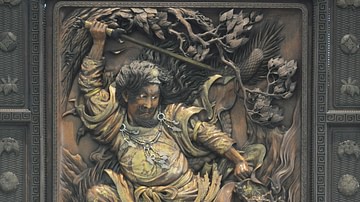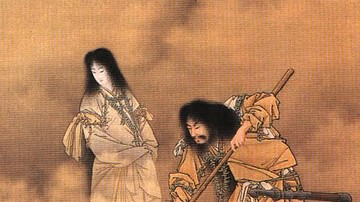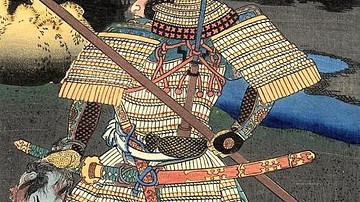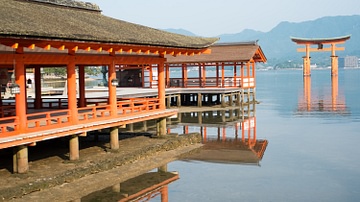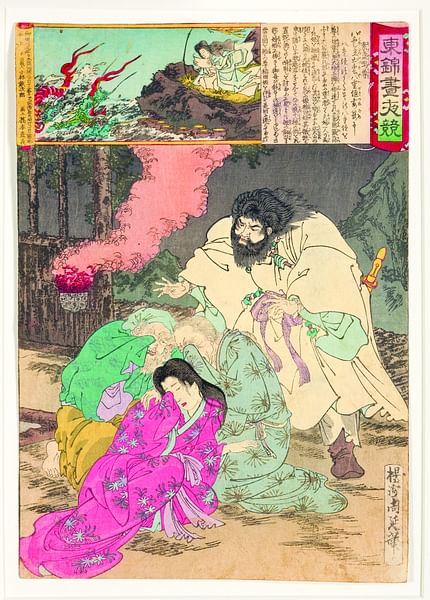
Take-haya-Susa-no-wo or Susanoo is the storm god of the Shinto religion. He is the younger brother of the sun goddess Amaterasu and infamous for his mischievous and sometimes destructive behaviour. Consequently, Susanoo has a reputation for being something of a trickster. Susanoo is associated with the wind and the sea and in more recent times has become associated with love and marriage.
Susanoo gave the Kusanagi sword to his sister Amaterasu and it later became part of the Japanese imperial regalia. Susanoo also gave the gift of agriculture to humanity. The god is honoured with a major Shinto shrine in Izumo Province.
Susanoo - A Troublesome Child
In Japanese folklore, the god was born when his father Izanagi washed his nose in the river Woto whilst performing ritual cleansing rites following his experience in the underworld. Initially, Susanoo ruled the Takama no Hara (High Celestial Plain) with his sister Amaterasu but from the very beginning, Susanoo caused trouble by destroying forests and mountains and killing local inhabitants down on earth. For this reason, he was banished from heaven.
Giving a last farewell to his sister, the storm god once again caused great destruction on his way to the palace of the sun and even the very mountains trembled in his wake. At this, Amaterasu was convinced her brother was up to no good but when challenged, Susanoo claimed he merely wanted to say goodbye and to prove his good intentions he said that if he could miraculously bring into the world five new deities and they turned out to be male, it would prove his honesty. Susanoo then took the 500-jewel necklace of his sister, ate them and spat them out as a mist from which five male deities were born. These new gods or kami, along with three female gods produced when Amaterasu performed a similar feat by eating Susanoo's sword and spitting out three deities, became the ancestors of the Japanese nobility.
Causing the Exile of Amaterasu
Full of exuberant joy at having won his challenge with his sister, Susanoo went on another wild rampage in celebration. Once again, trees were destroyed and so too many rice-fields. Then, to add insult to injury, in a rather tasteless joke Susanoo flayed a divine horse and threw it through the roof of the palace where Amaterasu was quietly weaving. Furious at her brother's outrageous behaviour, the sun goddess shut herself in a cave and only came out again after much palaver and enticements from the other gods. Susanoo, perhaps not unjustly, was immediately exiled from heaven. In some accounts Susanoo took up residence with his mother Izanami in Yomi, the underworld, in other versions he rules the realm of the seas.
Susanoo & the Eight-headed Dragon
Descending to the earthly realm, Susanoo landed at Tori-kami in the province of Izumo and whilst wandering along the river Hi, the god was arrested by the sound of weeping. Investigating further, Susanoo found three pitiful figures - an old man and woman and their beautiful young daughter - all sobbing uncontrollably and absolutely terrified by something. On enquiry, they told the god that their distress was caused by a gigantic serpent (known as Yamato-no-Orochi or the Koshi) which came to terrorize the region every year and every visit ate one of the aged couple's daughters.
Now the distressed parents were down to their last daughter, Kusha-nada-hime. Susanoo struck a bargain with them that if he killed the monster he could marry the beautiful girl. Agreeing to this, the parents followed the god's instructions and placed eight cups filled with extra strong sake at each of the doorways of their house. After a while, the monstrous serpent duly arrived with fire spitting from each of his eight heads. When the fearsome creature smelt the sake, it could not resist and each head drank from one of the cups. Consequently, the serpent collapsed completely drunk and Susanoo nonchalantly stepped out from his hiding place and lopped off each of the serpent's heads with his sword. Then opening the creature's belly, Susanoo discovered the special sword, the Kusanagi or 'grass-cutting sword' (in other versions of the story he extracts it from the serpent's tail). This sword, he presented to his sister, no doubt by way of apology for his earlier misdeeds. The sword was then given by Amaterasu to her grandson Ninigi who was the first ancestor of the Japanese imperial family and it became a part of the imperial regalia, preserved in the temple of Atsuta near Nagoya.
Susanoo's Gifts to Humanity
Despite his reputation as a bit of a bad boy amongst the Shinto gods, Susanoo is credited with giving certain cultural gifts to mankind, including agriculture. He is also credited with founding the ruling dynasty in Izumo, through his son-in-law Oho-kuni-nushi. It is also the location of a major Shinto shrine which is dedicated to the god. In Japanese art, Susanoo is most often depicted with wild hair blowing in the winds, wielding a sword and fighting the eight-headed monster Yamato-no-Orochi.


